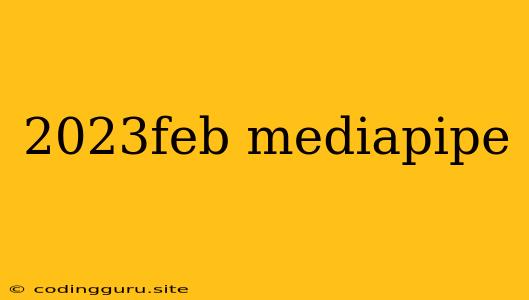MediaPipe: A Powerful Tool for Computer Vision in 2023
MediaPipe is an open-source framework developed by Google that provides a powerful and versatile solution for building real-time machine learning pipelines. It's a library that can be used across a variety of platforms, including mobile devices, web browsers, and servers. In 2023, MediaPipe continues to be a crucial tool for developers working in computer vision, with exciting new features and advancements.
What are some of the applications of MediaPipe?
MediaPipe is widely used for various tasks, including:
-
Image and Video Processing: MediaPipe offers tools for processing images and videos, including image segmentation, object detection, and tracking. These capabilities make it ideal for applications such as:
- Face Detection and Recognition: Identifying and recognizing faces in images and videos is a popular use case, with applications in security, access control, and social media.
- Pose Estimation: MediaPipe allows you to estimate the pose of humans in images and videos, which can be used for applications like fitness tracking, sports analysis, and animation.
- Object Detection and Tracking: MediaPipe excels at identifying and tracking objects in real-time, making it perfect for applications like augmented reality, robotics, and driverless vehicles.
-
Augmented Reality (AR): MediaPipe plays a critical role in AR by providing tools for object tracking, hand tracking, and face tracking. These capabilities allow for the creation of interactive and engaging AR experiences.
-
Healthcare: MediaPipe is increasingly being used in healthcare applications, such as:
- Medical Imaging Analysis: MediaPipe's image processing capabilities can be used to analyze medical images, assisting in diagnosis and treatment planning.
- Remote Patient Monitoring: MediaPipe can be used to track vital signs and other health indicators, enabling remote patient monitoring and telehealth solutions.
How does MediaPipe work?
MediaPipe uses a modular approach to create machine learning pipelines, allowing you to easily combine different modules to build custom solutions. These modules are designed to be highly efficient and can run on various devices, including mobile devices, web browsers, and servers.
The core components of MediaPipe include:
- Graphs: These define the flow of data and processing steps within a MediaPipe pipeline.
- Calculators: These perform specific operations on data, such as image processing, feature extraction, and classification.
- Packets: Data is transferred between calculators using packets.
- Side Packets: These provide additional information and metadata for each packet.
What are the benefits of using MediaPipe?
Here are some key advantages of using MediaPipe:
- Cross-Platform Compatibility: MediaPipe supports multiple platforms, making it easy to deploy applications on various devices.
- Open Source: Being open-source allows for a vibrant community of developers to contribute to its development and provide support.
- Performance Optimization: MediaPipe is designed for real-time performance, making it suitable for applications that require low latency.
- Flexibility and Customization: MediaPipe offers a wide range of modules and tools, allowing you to build custom solutions tailored to your specific needs.
- Community and Support: MediaPipe benefits from a large and active community of developers who contribute to its development and provide support.
How can you get started with MediaPipe?
-
Installation: You can install MediaPipe using Python's pip package manager:
pip install mediapipe -
Documentation and Tutorials: Google provides comprehensive documentation and tutorials on the MediaPipe website.
-
Examples and Demos: Explore the provided examples and demos to get a hands-on understanding of MediaPipe's capabilities.
What are some recent advancements in MediaPipe?
MediaPipe is constantly evolving with new features and improvements. Here are some of the recent advancements:
- New Modules: New modules have been added to address specific needs in areas like 3D hand tracking and object detection.
- Performance Enhancements: Improvements have been made to the performance of existing modules, making them faster and more efficient.
- Integration with Other Frameworks: MediaPipe is becoming increasingly integrated with other popular frameworks, such as TensorFlow and PyTorch.
Conclusion
MediaPipe is a powerful and versatile tool for building real-time machine learning pipelines. In 2023, MediaPipe continues to be a valuable resource for developers in the computer vision space. Its open-source nature, cross-platform compatibility, and performance optimization make it a popular choice for a wide range of applications. By leveraging its capabilities, developers can create innovative solutions that enhance user experiences and drive technological advancements.
